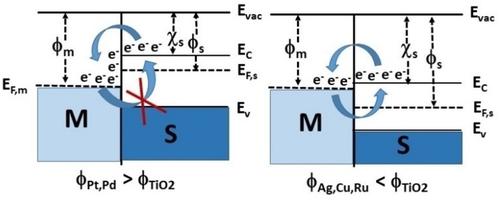当前位置:
X-MOL 学术
›
ChemistrySelect
›
论文详情
Our official English website, www.x-mol.net, welcomes your
feedback! (Note: you will need to create a separate account there.)
Effect of Metal Work Function on Hydrogen Production from Photocatalytic Water Splitting with MTiO2 Catalysts
ChemistrySelect ( IF 1.9 ) Pub Date : 2020-01-20 , DOI: 10.1002/slct.201904151 Charles Beasley 1 , Muthu Kumaran Gnanamani 1 , Eduardo Santillan‐Jimenez 1 , Michela Martinelli 1 , Wilson D. Shafer 2 , Shelley D. Hopps 1 , Namal Wanninayake 3 , Doo‐Young Kim 3
ChemistrySelect ( IF 1.9 ) Pub Date : 2020-01-20 , DOI: 10.1002/slct.201904151 Charles Beasley 1 , Muthu Kumaran Gnanamani 1 , Eduardo Santillan‐Jimenez 1 , Michela Martinelli 1 , Wilson D. Shafer 2 , Shelley D. Hopps 1 , Namal Wanninayake 3 , Doo‐Young Kim 3
Affiliation

|
Photocatalytic water splitting was performed on TiO2 and metal‐containing TiO2 (MTiO2) catalysts under UV light irradiation. TiO2 was added with various metals of different work functions, namely, Pt (5.93 eV), Pd (5.60 eV), Cu (5.10 eV), Ru (4.71 eV), and Ag (4.26 eV). The hydrogen production was found to increase linearly with increasing metal work function. The rate of charge recombination increases with decreasing work function difference between the metal and TiO2. Pt and Pd were highly efficient co‐catalysts to TiO2 for hydrogen generation from water due to their larger work function and upward‐bent band causing the photoelectrons to be trapped in those metal sites that are eventually consumed during water reduction. Co‐catalysts such as Ag, Ru, and Cu were less effective towards water splitting due to downward‐bent band gaps that allow the photoelectrons to flow back to TiO2 from the metal which leads to faster charge recombination.
中文翻译:

金属功函数对MTiO2催化剂光分解水制氢的影响
在紫外线照射下,对TiO 2和含金属的TiO 2(MTiO 2)催化剂进行了光催化水分解。TiO 2加入了具有不同功函数的各种金属,分别是Pt(5.93 eV),Pd(5.60 eV),Cu(5.10 eV),Ru(4.71 eV)和Ag(4.26 eV)。发现氢的产生随着金属功函数的增加而线性增加。电荷的复合率随着金属与TiO 2的功函数差的减小而增加。Pt和Pd是TiO 2的高效助催化剂由于其较大的功函和向上弯曲的谱带,导致水从水中产生氢,使光电子被困在最终在减水过程中消耗的金属部位。由于向下弯曲的带隙使光电子从金属流回到TiO 2,导致更快的电荷复合,因此,银,钌和铜等助催化剂对水的分解效果较差。
更新日期:2020-01-21
中文翻译:

金属功函数对MTiO2催化剂光分解水制氢的影响
在紫外线照射下,对TiO 2和含金属的TiO 2(MTiO 2)催化剂进行了光催化水分解。TiO 2加入了具有不同功函数的各种金属,分别是Pt(5.93 eV),Pd(5.60 eV),Cu(5.10 eV),Ru(4.71 eV)和Ag(4.26 eV)。发现氢的产生随着金属功函数的增加而线性增加。电荷的复合率随着金属与TiO 2的功函数差的减小而增加。Pt和Pd是TiO 2的高效助催化剂由于其较大的功函和向上弯曲的谱带,导致水从水中产生氢,使光电子被困在最终在减水过程中消耗的金属部位。由于向下弯曲的带隙使光电子从金属流回到TiO 2,导致更快的电荷复合,因此,银,钌和铜等助催化剂对水的分解效果较差。











































 京公网安备 11010802027423号
京公网安备 11010802027423号